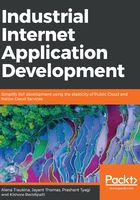
上QQ阅读APP看书,第一时间看更新
IoT business models
As the penetration of the IoT continues in various industry verticals, we will see new business models evolve and new and creative ways of generating value for the end customers and therefore generating revenue. Before we look at possible emerging business models, it's important to take a deeper look at how these technologies are being used today. We can divide the use of IoT technologies into the following broad categories:
- Smart monitoring of the existing product or service install base: The products and services that businesses sell today have monitoring, alerting, and reporting solutions. However, these are siloed and not interconnected with each other or to the internet. That limits their utility and usage; the IoT will enable these monitoring solutions to be smart in the true sense of the word.
- Smart remote diagnostics: It is another area where businesses have started using IoT technologies. This is especially useful for verticals where the operating conditions are harsh and not suitable for human intervention and involvement at all times. The ability to seamlessly integrate edge solutions with the internet has enabled companies to take remote operations to the next level.
- Cross vertical domain data integration: This allows businesses to generate new insights by integrating data and correlating parameters to identify new trends. An example would be the integration of weather data with operational maintenance data for an asset that is deployed in the field and exposed to weather conditions. The integration of these data points will help discover new models for remote monitoring and diagnostics for the asset.
- Product/service promotion: It can be augmented by IoT devices as they can help transmit messages to a customer's smart phone and other devices, which will help them be aware of new promotions and products available in their vicinity. They can also help with targeted ads to be delivered on billboards, and so on.
- Creating open and scalable interfaces for products and services that were earlier closed systems: For example, the automobile industry, which produces engines and power trains for vehicles, are now exposing these assets through interfaces such as software APIs that help with the tracking and maintenance of these systems.